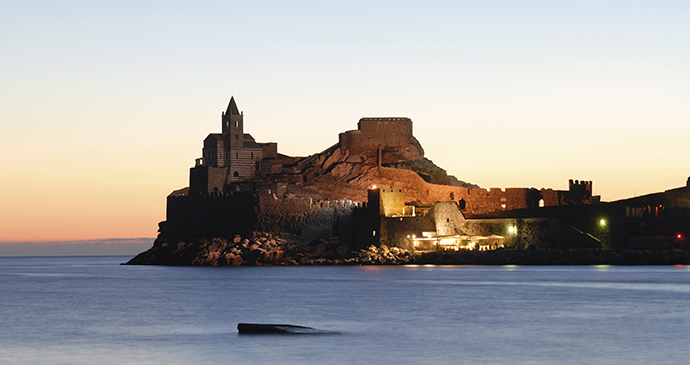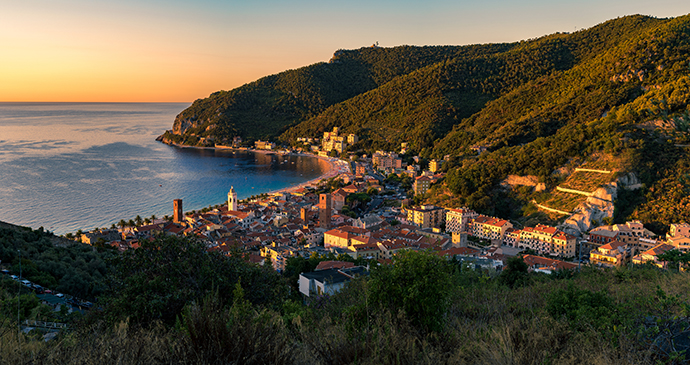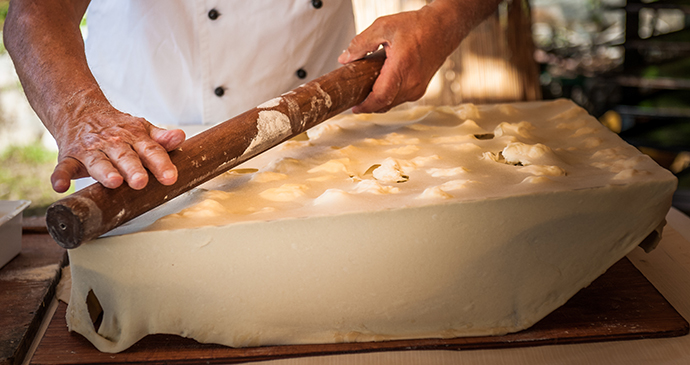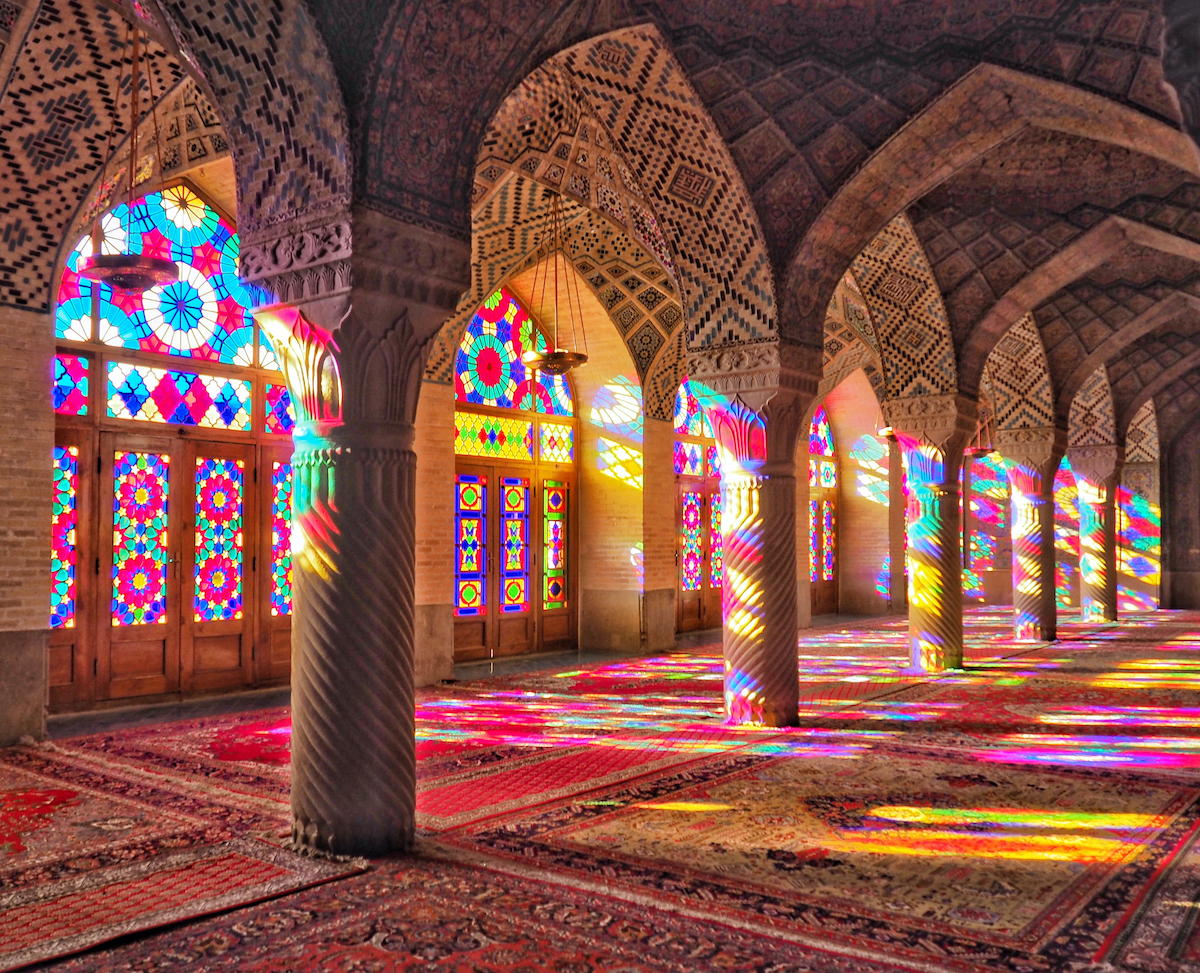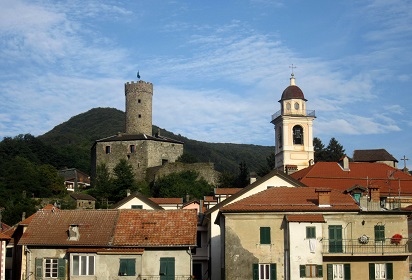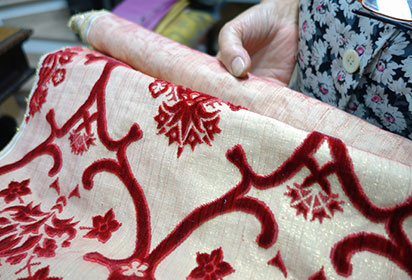There are things about Liguria that are totally unique. People still speak dialect and eat food only found in certain areas even within Liguria itself.
Rosie Whitehouse, author of Liguria: the Bradt Guide
Liguria – in northern Italy – overlooked by modern tourists, is a land of hilltop villages, picturesque ports, mouth-watering food and fascinating history.
Genoa was once a maritime superpower that bankrolled the Crusades and the Spanish conquest of America. It’s an atmospheric port city of medieval alleyways but also home to some of Italy’s most sumptuous palaces and fabulous art collections. Genoa enchanted Byron, Dickens and Henry James, who thought the city was ‘the queerest place in the world’. Among Genoa’s treasures is its fantastic cuisine; basil is king of the kitchen. In Petrach’s opinion the city was ‘La Superba’, Genoa the Proud.
Liguria has some of the most stunning coastline in Italy, which includes the Cinque Terre. Dramatic cliffs plunge into a deep blue sea, the saltiest in the Mediterranean. There are tiny rocky coves and beautiful seaside villages like glitzy Portofino but others, just as beautiful, yet little known outside Italy.
The mild climate makes this an all year round destination – this is after all the Italian Riviera where the European aristocracy wintered in the 19th century. Yet Liguria isn’t all about glitz. Ligurians like the simple life and the hinterland is well off the tourist track. Walk along mountain paths with panoramic views stretching from Corsica to the Alps.
This is the place for a truly Italian experience. Here you will find tumbled down villages where grannies toddle home from the shops while old men gossip in the sun. How they get away with it I do not know!
For more information, check out our guide to Liguria
Food and drink in Liguria
Restaurants tend to open from 12.30 to 15.00 and from 19.00 until late on the coast. Inland restaurants often close at 21.00. Not all restaurants open for lunch and some only open at weekends. There is a smoking ban in cafés, restaurants and bars. Ligurians don’t eat much for breakfast. It’s usually a shot of espresso and something sweet. Italian breakfast is a kid’s dream. In good B&Bs and agriturismi you will get a mouth-watering array of cakes and biscuits. Hotel breakfasts are often a waste of time, so avoid paying for them if you can and go to a café.
Ligurians have a reputation for hard work and are more likely to eat a piece of focaccia, fl at bread, than sit down on a daily basis to a large lunch. Part of this culture probably came from the fact that when the men were away at sea, the women were busy keeping the place ticking over, so didn’t have time to cook, and preferred to skimp, so there was plenty when their husbands returned home. Meals are less formal in Liguria, and less rigid than in other parts of the country.
Genoa’s Chamber of Commerce supports restaurants that use local ingredients and serve local dishes and Ligurian wines. Those that meet their criteria are given the Genova Gourmet stamp of approval, as are local producers making traditional food products.
The taste of Liguria
Food is an essential part of the Ligurian experience and a very local affair. All of Italy’s regions have their own distinctive dishes, many of which are never eaten out of the area in which they are made. In Liguria the dishes change from village to village much like the dialect, although there is a core group of common ingredients and techniques. The isolated narrow mountain valleys were linked only by dirt-track roads right up until the 1960s and, as a result, each had their own cuisine based exclusively on what was at hand. As a result it is a lean and healthy diet centred on vegetables, fruit, olive oil, wine, pasta and fish. The wild herbs that grow on the Ligurian hillsides are the basis of nearly every dish and were traditionally harvested to make preboggion, a mixture of herbs that have been simply boiled and dressed with olive oil and lemon. This mixture is used to stuff the large triangular pasta, pansotti, and to fill gattafin, a large, fried ravioli from Levanto.
Nowadays all Ligurians eat local variations of pesto, basil sauce; focaccia, a flatbread with olive oil; farinata, a chickpea-fl our pancake; rabbit with olives and herbs; rockfish and anchovies in soups, stews and tarts, or stuffed, fried or grilled; stoccafisso, dried cod; ravioli or other filled pasta; vegetable tarts and stuffed vegetables; and pandolce, a cake with candied fruit. Similarly, every serious kitchen from Sarzana on the edge of Tuscany to Ventimiglia bordering France will be stocked with local olives and oil, pine nuts, salt-preserved anchovies, fresh and pickled vegetables like courgettes, chard, tomatoes and aubergines, white beans, chickpeas and preserved mushrooms, and the region’s ubiquitous herbs.
Extra virgin olive oil has sat at the heart of Ligurian cuisine since ancient times and is the key ingredient in the best-known Ligurian delicacies such as focaccia, farinata and pesto sauce. The most famous varieties are made from taggiasca, pignola, lavagnina and razzola olives and since the 16th century it has been an important local industry, especially in the hills and mountains behind Imperia. Here the olive oil, thanks to the more temperate climate, is more delicate and fruitier than that produced in other parts of Liguria. Taggiasca olives are a tasty aperitif and are used to make the local olive paste.
Extra virgin olive oil has sat at the heart of Ligurian cuisine since ancient times and is the key ingredient in the best-known Ligurian delicacies such as focaccia, farinata and pesto. The most famous varieties are made from taggiasca, pignola, lavagnina and razzola olives and since the 16th century it has been an important local industry, especially in the hills and mountains behind Imperia. Here the olive oil, thanks to the more temperate climate, is more delicate and fruitier than that produced in other parts of Liguria. Taggiasca olives are a tasty aperitif and are used to make the local olive paste.
The king of the Ligurian kitchen is, however, basil. Indeed the word basil, basilico in Italian, comes from the Latin translation of the Greek βασιλικός, meaning ‘regal’. The best basil in the world is grown in Liguria, in giant greenhouses perched precipitously on the hillside between the motorway and the rather run-down flats of Genova Prà. With a view of the docks and the salty air, it’s the perfect stressful environment to grow a really pungent basil plant. Basil is a serious affair and since 1992 the Confraternita del Pesto have guarded the authenticity of the sauce.
Wine
Liguria doesn’t produce vast quantities of wine and it is little known outside of the region. Wines are classified according to DOC, Denominazione di Origine Controllata, which means that it has been produced according to prescribed standards and quality. DOCG, Denominazione di Origine Controllata e Garantita, applies to very few wines, notably Barolo from just over the border in Piedmont, which is widely available, and the fortified Sciacchetrà from the Cinque Terre.
Try Rossese, a ruby-coloured red that turns a garnet colour as it ages and which complements meat and game dishes. It comes from the vineyards around the ancient village of Dolceacqua near Ventimiglia. The vines grown in the high Arrosica Valley behind Imperia produce Ormeasco, another red wine which comes from the vineyards around the dubiously named Pornassio, which has the same connotations in Italian. This local wine goes under the name of nearby Ormea. Closer to the coast Pontedassio, San Lorenzo and Diano Castello are the home of Vermentino, a fresh white wine that is a good accompaniment to fish and seafood appetisers. The Vermentino produced around Sestri Levante is also good.
Pigato from the Albenga Valley, notably the tiny villages of Salea, Ortovero and Ranzo, is a lightly fragrant straw-yellow white wine with a bitter almond taste. In the vineyards around Finale they produce a particular, fresh and slightly acid white wine, Lumassina, also called Buzzetto, which in dialect means ‘still unripe’; so-called as it is made with grapes that ripen late. Close to Genoa the local wine is from the Val Polcevera. It is a white wine which is both still and sparkling.
Sparkling wines are also produced in the Golfo del Tigullio. Further east, in Levanto, the Colline di Levanto quality assurance label protects both white and red wines, and both are worth looking out for. The grapes from the precipitous vineyards that cling to the cliffs of the Cinque Terre turn into Sciacchetrà, made from grapes naturally dried on mats. The Romans admired the wine from the hills around Luni, Colli di Luni, which has become increasingly popular in recent years.
Health and safety in Liguria
Health
Liguria poses no major health risks. Tap water is safe to drink, but it is wise to be up to date with routine vaccinations in the UK such as measles, mumps and rubella, and diphtheria, tetanus and polio. Mosquitoes are an issue in the summer months at night, and in shady areas during the day, so be prepared with a good insect repellent. Big supermarkets stock a wide range of anti-mosquito ammunition and it is far cheaper than the equivalents sold in pharmacies.
Pharmacies (farmacie, sing. farmacia) are usually open 09.00–13.00 and 16.00–20.00 on weekdays and some close on Saturday afternoons. They are usually closed on Sunday, but in high season may open in resort towns. A pharmacy that is open out-of-hours on a rotation basis is called a farmacia di turno. A rota will be posted on the door of the pharmacy or on federfarma.it.
EU nationals who are taken ill or have an accident when visiting Italy areentitled to health care. The European Health Insurance Card improves access to health care in the EU and speeds up the reimbursement of costs (replacing the E111 form). UK citizens can apply for this card through the EHIC website, or by calling 0845 606 2030, but note that participation in the scheme may change for UK citizens post-Brexit.
Only publicly funded health treatment is included in this scheme for the moment. In Italy, while emergency treatment is free for visiting EU citizens, you have to pay the full cost of drugs and nonemergency treatment and then claim a refund. It is important to keep all your bills, prescriptions and receipts.
In Italy free emergency health care is available to foreigners, but any required medication or follow-up treatment will have to be paid for. It is therefore important to ensure that your travel insurance covers medical costs. Take a copy of your policy certificate with you and keep the policy number to hand in case you are obliged to quote it. Keep all receipts.
Prevention being far better than cure, walkers and hikers should be conversant with first aid, and know how to deal with injuries and hypothermia. Try to avoid walking or climbing beyond your limits. The majority of accidents happen when you’re tired. In the event of being injured, use surgical tape for cuts that would normally be stitched, and then bind the wound laterally with zinc oxide tape.
In the extremely unlikely event of being bitten by a snake, try not to panic, as a racing heart speeds up the spread of venom – much easier said than done, of course. Most first-aid techniques do more harm than good. If possible, splint the bitten limb and keep below the height of the heart, then get the victim to hospital immediately.
Travel clinics and health information
A full list of current travel clinic websites worldwide is available on istm.org. For other journey preparation information, consult travelhealthpro.org.uk (UK) or wwwnc.cdc.gov/travel (USA). Information about various medications may be found on netdoctor.co.uk/travel. All advice found online should be used in conjunction with expert advice received prior to, or during, travel.
Safety
There are no major crime issues in Liguria, but do beware of pickpockets and keep your handbag or wallet in a safe place at all times wherever you are. This is especially true in stations. Think twice before sleeping with all the windows open; it is an easy mistake to make if you don’t come from a very hot country. Thieves can easily jump in through the window while you are asleep. Use your common sense and ask advice. Genoa’s old town has a notorious red-light district; its narrow darkstreets can be a little dodgy at night.
Forest fires are frequent in the hot summer months and fed by the almost constant breeze. There is a lot of speculation as to how many of them are actually started deliberately and it is not uncommon to see firefighting planes flying down to the sea to scoop up water to put them out.
Up in the mountains it is essential to never light a fire outside of designated areas and to make sure that all cigarettes are put out properly. Be careful walking in forests in October on Wednesdays and Sundays. This is the hunting season!
Female travellers
There are no real issues involved in travelling alone, or in small groups, as a woman in Liguria, which can’t be found travelling alone in any other western European country. That said, it is best to avoid Genoa’s old town after dark. The areas around its two railway stations are also a little dodgy at night. Just remember that Italy is a pretty sexist country so make sure you have a thick skin.
LGBTQ+ Travellers
Not only is Italy sexist but it is prejudiced on all fronts, so a normal amount of discretion is advised. Hotel workers are unlikely to question a gay or lesbian couple requesting a double room. There is a gay scene in Genoa with a number of gay bars. There is a useful website in Italian: arcigaygenova.it.
Travellers with a disability
Liguria isn’t an easy place to visit if you have reduced mobility, largely because old medieval cities and villages perched on mountainsides aren’t the easiest places to get about in a wheelchair or with a walking stick. That said, one organisation that offers services in Italy to travellers with disabilities is Accessible Italy (+378 941111; [email protected]). There is also a guide in Italian and French for visitors with disabilities by local organisation La Cruna.
For pre-travel information, Gov.uk provides a useful resource. The Society for Accessible Travel and Hospitality provides some general information, too. Disabled Holidays offers accessible holidays to Italy, including Liguria.
Travelling with kids
Liguria is a great destination for children. Even though Italians aren’t having many of them themselves these days, Italy is still one of the most child-friendly places in the world. Don’t expect lots of specific things for children in museums, restaurants and hotels, however, but what you do get is a warm welcome.
All towns along the coast have carousels, rides or mini cars. Beach clubs are all kitted out to accommodate kids, as Liguria is above all a family destination. There’s sun and the sea in summer and fun to be had inland up in the mountains. With an ice-cream shop on every corner and endless vending machines selling trinkets, it is easy to calm the nerves of a trainee traveller. Genoa has a number of attractions that go down well. There is a vast aquarium and a number of museums aimed specifically at children.
There is no need to bring supplies from home if you have babies or tiny children.You can buy everything you need; even special pasta for babies.
You will find that some elderly people, or those who don’t have children, are not that tolerant of noise. Italians expect quiet in the early afternoon in summer so they can siesta. Pushchairs can be difficult in hilltop towns and on cobbled streets. Their wheels can get stuck between the stones, so always make sure your little passenger is strapped in or bring a sling.
If you are coming from the UK, always be extra vigilant about traffic safety as Italians drive on the right-hand side of the road. Also note that cars don’t stop automatically at a pedestrian crossing, even when the light is green. With older children make sure their mobile phones are activated to work abroad and that they have your numbers keyed in with the relevant country code.
Travel and visas in Liguria
Visas
Citizens from EU member states and those of Albania, Bosnia-Herzegovina, Macedonia, Montenegro and Serbia do not need visas and can stay in the country as long as they like. The holders of passports from the following countries do not need a visa for a stay of 90 days or less: Andorra, Argentina, Australia, Brazil, Brunei, Canada, Chile, Costa Rica, El Salvador, Guatemala, Honduras, Hong Kong, Israel, Japan, Macao, Malaysia, Mexico, Monaco, New Zealand, Nicaragua, Panama, Paraguay, Singapore, South Korea, Switzerland, United States, Uruguay and Venezuela, and, very likely, the UK post-Brexit. All other nationals should consult their relevant embassy about visa requirements or take a look at the website schengenvisainfo.com.
In theory all foreigners are required to register their presence with the police; for this reason you will always be asked for your passport details by a hotel or B&B, so keep it with you as you travel about. Individuals in reality rarely do so if they are simply on holiday. If you intend to stay longer, it is advisable, however, to register at the local police station.
Getting there and away
By air
Genoa’s Cristoforo Colombo Airport is 6km west of the city in the suburb of Sestri Ponente (010 6015410). At time of writing it was undergoing a makeover that is due to be completed in 2021. It will improve connections to Genoa, which are notoriously bad. The number of destinations is set to rise from 26 to 40 over the next few years. Buses are infrequent so it is wise to factor a taxi ride to the centre into your calculations if you are not on a tight budget. The rate is shown on a notice at the taxi rank and is €7 per person for three people, meaning if you are travelling alone, you’ll pay €21. It is worth flying into Liguria, however, for the breathtaking experience of landing on the runway that juts out into the sea. Ask for a seat on the right-hand side of the plane and you will get a bird’s-eye view of Portofino and Genoa. It takes roughly 2 hours to fly from London.
Ryanair and British Airways fly directly from the UK, the former from London Stansted and the latter from London Gatwick. Easyjet fly from Bristol, London Luton, and Manchester. The closest airports with direct flights from North America are Milan and Nice. If you are coming from Australia or New Zealand, you are likely to fly into Milan or Rome. If your destination is the eastern end of the Riviera, then consider flights to and from Pisa Airport (050 500707), which is just 84km from La Spezia. Trains from Pisa connect with La Spezia in 50 minutes. If your destination is the western end of Liguria, it is well worth flying to Nice, which has direct flights from the UK from Bristol, London Gatwick, London Luton, London Heathrow, Liverpool and Manchester on easyJet, British Airways and Ryanair, and direct flights from North America. Note that some connections are seasonal.
By boat
Ferries leave from Genoa for Algeria, Tunisia, Corsica, Sardinia, Sicily, Barcelona and Tangier. Genoa is also an important destination for cruise ships. The other two large ports in the area are Savona and La Spezia. The latter is principally a naval port but Costa cruises start in Savona and ferries leave from nearby Vado Ligure for Corsica. Liguria has 34 tourist ports and a growing number of marinas and, with berths for more than 17,000 boats, is Italy’s most organised region for hosting pleasure craft .
Getting around
Public transport is good. For timetables and routes, see www.orariotrasporti.regione.liguria.it.
By boat
There are frequent ferries in the summer and a number of companies run whale-watching trips. There are also night-time excursions to see the firework shows that take place throughout the summer. A boat trip is a must as it really puts you in touch with Liguria’s seafaring side and it is wonderful to see it from the sea. There are a number of companies who hire small sailing boats, with or without a crew. See individual town listings for details.
By bus
Buses also run along the coast and up into the mountains. Services are regular but not frequent. Bus fares within towns are usually inexpensive and are likely to cost around €2.
By car
To really explore the mountainous hinterland it is better to have a car. Beware however that many of the roads are narrow and extremely winding. Some parts of the coast can be very busy in summer and long queues can result. Although there is a car park at Monterosso al Mare, parking can be difficult or near impossible in the Cinque Terre.
By motorbike
When Piaggio made their first Vespa in 1946 they revolutionised Italian life. Suddenly it was possible to get out of the city and spend the afternoon on the beach. Since production began, over 3 million Vespas have been manufactured in Italy; today the roads are full of Vespas and hiring one can add an authentic touch to a holiday. You can rent scooters from Ligurent (320 7224142). Many locals explore the hinterland at the weekend on motorbikes. For more information on the history of Piaggio, see bradtguides.com/piaggio.
By train
The railway runs along the coast. Regular services stop at all the stations along the route. The train is an excellent way to visit Liguria’s big tourist draw, the Cinque Terre. Some trains also stop in the hinterland en route for Turin, Milan and Parma.
When to visit Liguria
Climate
It is generally a sunny place with an average of 4 hours of sunshine a day in winter and 9 in the summer. Indeed it is one of the sunniest places in Italy despite its northerly position. Annual average relative humidity is 68%, ranging from 63% in February to 73% in May. Rainfall can be abundant at times, and Genoa and La Spezia can see up to 2,000mm of rain in a year. October and November are the wettest months. Waterspouts, tromba d’acqua, have become increasingly common in recent years. They are, put simply, tornadoes that happen over the sea. In bad weather it is advisable to take shelter inside as heavy rain can cause dangerous flooding and when a waterspout hits land it can cause considerable damage. Snowfall is sporadic, but does occur once or twice per year.
The average yearly temperature is around 19°C during the day and 12°C at night. Even in the coldest months of January, February and March, the average daytime temperature is 12°C, which makes for a pleasant stay even in the depths of winter. The average yearly temperature range is only 5.4°C, which is one of the lowest in Italy. In summer, it is usually between 25°C and 28°C, and 21°C at night; temperatures are lower than in other parts of Italy as the sea breezes cool the air, although in a heatwave temperatures can reach 36°C. The sea is generally warm and from June to October is 19°C or higher. It is mainly calm, with a tidal range of 30cm.
Don’t be fooled by the sea, which can look like a millpond. The Italian Riviera isparticularly prone to fierce storms, heavy rainfall and rough seas, so always check weather reports before setting out.
Liguria is a windy place and the wind usually blows from the southeast, bringing humid and warmer air from the sea. Summer often comes to a close with dramatic thunderstorms that feel like they have jumped out of Mary Shelley’s Frankenstein.
When to visit
With the mildest of climates, tourists visit Liguria at all times of the year, but November and February can be wet and are best avoided. There are things to do all year round: from fascinating museums and fabulous palaces to visit, to beaches and wild mountain countryside to explore.
There is, however, a clearly defined high-season that runs from May to September and the coast can get very busy, especially at weekends. It is hot in Liguria in summer and it is not the best time to explore Genoa. It is essentially a beach experience in this season but it is also a beautiful period to spend time in the mountains, which are degrees cooler than the coast. August can be disappointing for visiting Genoa, as many restaurants close for the entire month and the city can be uncharacteristically empty.
In winter, when the air is clear and the views are at their best, it is a joy to walk along the Cinque Terre path in peace and gaze out across the sea to Corsica. Spring and autumn are best for sightseeing and any kind of sporting activity that doesn’t involve cooling off in the sea.
What to see and do in Liguria
Apricale
Apricale tumbles down a crag, a short drive above Isolabona in the Val Merdanzo. This is the place to base yourself to explore the area. The village takes its name from the Latin apricus, meaning sunny. Many of the buildings date from the 11th century and the town hosts theatrical events, some in medieval and Renaissance costume in summer.
What is lovely about Apricale is that it has only just opened up to tourists and has lots of charm. Less and less of the village sits abandoned these days as the town resounds to the sound of restoration as builders hammer away. Living was hard in the hinterland and many people upped and moved to the coast where there were jobs, schools and hospitals. Without tourism it is possible that the village would have been totally abandoned so it is good to see it coming back to life. It is great fun to explore Apricale’s dark alleyways, which are more like tunnels. It is full of cats and uneven cobble stones. You’ll soon notice that most of the foreigners are Swedish. That’s because a Swedish artist came here in the 1960s and painted the town. His work inspired his friends to buy houses here and they now own about 20% of the property in Apricale.
Just off the coast of Porto Venere, Liguria’s only archipelago is a must-see for visitors © Photo Archive Regional Agency in Liguria
Archipelago near Porto Venere
Liguria’s only archipelago lies just off Porto Venere and the islands are a must-see of any visit here. There are regular boats across the narrow strip of water to Palmaria, the largest of the three islands, where there are some lovely beaches, especially on the side that faces out to sea. This is also a good place to walk. Boats leave from the harbour side for a tour of all three and take you close up to the towering cliffs that are striped with black stone just like the pretty church of San Pietro. Rare black portor marble was once quarried here. It’s still possible to see where the stone was brought down and loaded on to boats and the area where it was quarried looks like it has been literally cut by a knife, like a slab of butter. Palmaria’s Grotta dei Colombi, the Doves’ Cave, looks out over the island of Tino and is the most important cave in eastern Liguria, not only in terms of its size, but also because of the prehistoric remains that have been found here.
Genoa
Genoa is a real port city. When Welsh poet Dylan Thomas arrived here in 1947, he wrote home to his parents, ‘The dock-front of Genoa is marvellous. Such heat and colours and dirt and noise and loud wicked alleys with all the washing of the world hanging from the high windows.’ Genoa is still a vibrant, sometimes intimidating place, that’s definitely on the up.
American writer Henry James described Genoa in 1909 as the ‘queerest place in the world’, and it is certainly different from any other Italian city. Until recently it wasn’t on the tourist trail at all and, despite efforts to clean up the old town, you will still see prostitutes, even on a Sunday morning. Yet, as James pointed out, ‘it is not fair to speak as if at Genoa there were nothing but low-life to be seen, for the place is the residence of some of the grandest people in the world’. That is certainly the case. Once a maritime superpower, Genoa has some of the most sumptuous palaces in Italy.
In many ways Genoa is like London: it was badly bombed in World War II and hastily rebuilt in the post-war boom years without any consideration for aesthetics. The Genoese are regarded by their fellow Italians as penny-pinching, and despite the city’s extraordinary wealth in the Middle Ages and the Renaissance, they never spent anything doing up Genoa. As a result, it has Europe’s biggest and bestpreserved medieval town, which James believed, ‘it would be almost impossible to modernise’. He might well be proved wrong. There is a trendy feel descending on the old town as in the last couple of years hip bars, cafés and shops have begun to open up.
First impressions of Genoa are nearly always wrong. Dickens was taken aback, ‘I never in my life was so dismayed!’ and ‘the disheartening dirt, discomfort, and decay; perfectly confounded me’. He wrote later, however, ‘It is a place that “grows upon you” every day. There seems always something to find out in it… It abounds with the strangest contrasts; things that are picturesque, ugly, mean, magnificent, delightful and offensive, break up the view at every turn.’
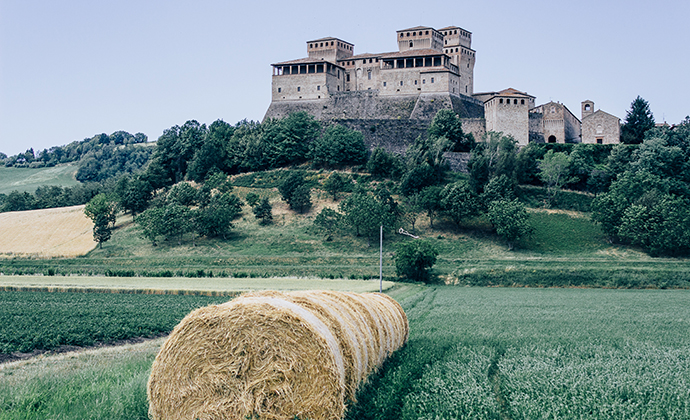
Langhirano
The foothills south of Parma are the source of much happiness – almost all of the famous Parma hams are produced here, as well Parmigiano cheese, DOC Colli di Parma wines, mushrooms (porcini in autumn, prugnolo in spring) from Borgo Val di Taro, and truffles from around Calestano.
The Taro Valley was always an important route through the northern Apennines. It branches at Fornovo; one road (the SS308) follows the river before crossing the mountains into Liguria, and another (the SS62, paralleled by the A15 motorway) takes a more tortuous path over to Tuscany. Such a strategic area naturally has sprouted plenty of castles.
The most photogenic of all the duchy’s castles, Castello di Torrechiara is a magnificent brick fantasy, almost unchanged since it was built by Pier Maria Rossi ‘Il Magnifico’ (1413–82), humanist, linguist, astronomer and military captain. Visible from miles around, it’s defended by a double set of walls and four mighty towers, each surrounded and linked by covered walkways.
The elegant courtyard has ornate terracotta tiles; the ground floor has excellent frescoes by Cesare Baglione, who also painted the delightful cycle of acrobats performing impossible feats with hoops on the backs of lions. The castle’s best frescoes, however, are by Bonifacio Bembo in the beautiful Golden Bedchamber, where Pier Maria brought his young lover Bianca Pellegrini, and where he died in her arms. Bembo covered the walls with gold leaf (now gone) and a fresco cycle dedicated to their love and the Rossi’s 40 other castles.
Situated just above sea-level, Noli sits right on the beach © Job Pagaduan, Shutterstock
Noli
Huddled under craggy Monte Ursino, Noli is a picturesque, miniature, walled town, which is one of the best-preserved medieval cities on this stretch of the coast. Just 4m above sea level, Noli sits quite literally on the beach. There is a small palm-fringed promenade and a good little public beach with rough sand. Pulled up on the sand are rows of little boats belonging to the local fishermen, who set out every night to gather their catch. Noli has lots of charm, makes a great day trip and is a good place to base yourself for a holiday.
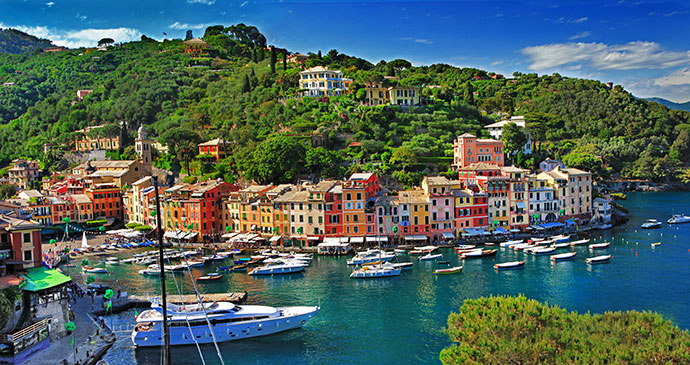
Portofino
Portofino’s tall colourful houses curve around the bay in a cove that forms a perfect miniature harbour protected from behind by steep green hills. When Frederic Lees arrived here in 1912, Portofino was famous for fish and lacemaking. He found it ‘as snug and as sunny a little port as ever a mariner could desire, and so picturesque that I know not where you would find a prettier’. The charm of the place was to watch the women sitting on cushions under the porticoes with their bobbins clicking away.
Late Victorian writers gushed about the beauty of the village, not without reason, and began a process that turned this sleepy little harbour into a celebrity Mecca. The woods behind are dotted with the villas of the rich and famous. That said, it is still one of the most picturesque spots in Liguria and best seen out of the main summer holiday season when streams of tourists descend on it during the day.
Despite its unassuming architecture, Recco’s food is among the finest in Liguria © Lullaby7, Shutterstock
Recco
The town of Recco itself is nothing special and was flattened by British and American bombers during World War II in their attempt to take out the railway viaduct. The buildings date from the 1950s and 60s and, at first glance, it appears a little soulless. However, its soul can be found in its amazing cuisine: the locals have hung on to their food heritage so steadfastly precisely because there is little else left.
The big date in the calendar is 7–8 September when they celebrate the Sagra del Fuoco, the firework festival in honour of their patron saint, Nostra Signora del Suffragio.
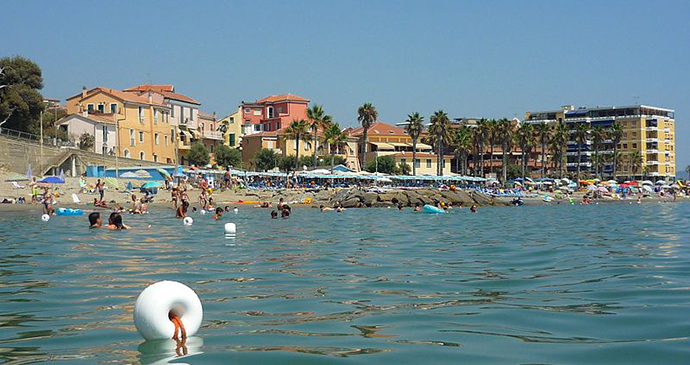
Taggia
Here the valley flattens out and, as a result, it is covered in greenhouses and light industry. The Riviera dei Fiori starts in earnest here but don’t imagine fields of flowers: the blooms here are all hidden under cover. One’s first reaction is to turn tail and run, but that would be a big mistake.
Arma di Taggia has one of the best sandy beaches on this stretch of coast and is a bustling seaside resort. If you avoid the eastern end with its 1960s blocks of holiday flats and stay at the western end by the old town, it’s a pleasant place to while away a couple of days. Its medieval twin, Taggia, sits surrounded by its 16th-century walls 3km inland. This is Taggia’s cultural face, but it’s off the tourist track and bursting with tumbledown charm.
The Alta Via dei Monti Liguri
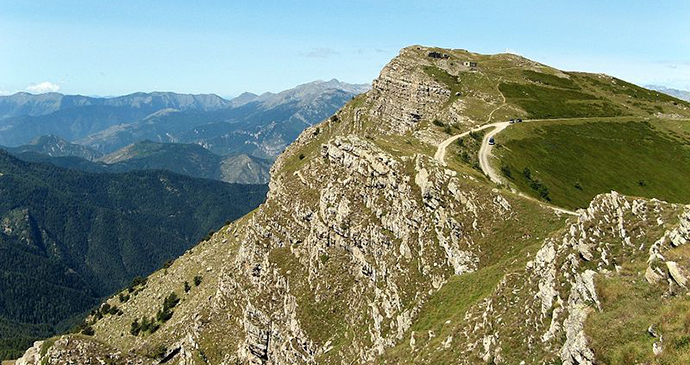
Liguria is a great destination for walkers and is covered in trekking paths. The Alta Via dei Monte Liguri is a 440km footpath that runs the length of Liguria along the top of the mountains. It’s Italy’s longest continuous pathway reaching its highest point at 2,200m on Monte Saccarello. It’s divided into 43 sections that take two to three hours to walk. Mountain refuges dot the path.
You don’t have to be a serious walker to enjoy it. In places it is fairly flat and even possible to negotiate with small children. On a hot day on the coast the air on the mountains is degrees fresher. Pack a picnic and soak up the stunning views. On the western stretch on the path late spring sunshine brings out the wild flowers while the Ligurian Alps that mark the Italian border with France are still capped in snow.
Some of the best views are to be had in the depths of Liguria’s wonderfully mild winters when it’s possible to spot Corsica rising from the sea. Yet even in summer when the skies are clear you can catch a view of the Alps to the north. Much of the path runs through protected parkland; wild flowers and butterflies abound. Pick wild raspberries and blackberries as you stroll along the paths.
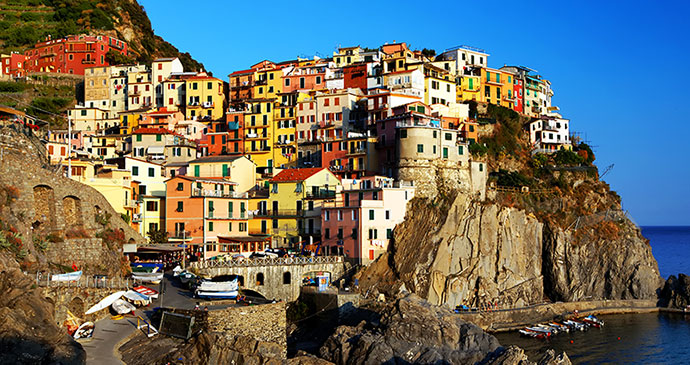
The Cinque Terre
The Cinque Terre, despite its fame, is actually quite a mellow place if you know where to go, and is absolutely stunning. It is made up of five little villages that sit like limpets on the cliffs; terra is an old word for village. The five villages of Monterossa al Mare, Vernazza, Corniglia, Manarola and Riomaggiore have retained much of their original charm and the area was declared a UNESCO World Heritage Site in 1997. To see the Cinque Terre properly, it’s best to stay a night or two in order to catch a real feel for the place.
There isn’t a list of must-do things to tick off – this is a place to unwind, enjoy the outdoors, take a boat trip, swim in the sea and paddle in the rocky rivers. That said, if you try to go on a day trip to the Cinque Terre in July and August and base yourself in Monterosso, Manarola or Riomaggiore, you can easily end up burnt out and overwrought. These three towns attract the highest number of day-trippers and are very busy in the summer. To avoid the crowds, centre your visit on the coast in Corniglia and Vernazza and inland, in and around Pignone or Varese Ligure. Corniglia, as it is high up on the cliffs, is the one of the five villages that tends to get left out of day trippers’ itineraries, and Vernazza retains an ability to rise above it all, as it is simply the nicest of the five.
Val di Vara
The lush Val di Vara is more undulating than the steep valleys that make up much of the Ligurian hinterland. Above all, it’s an agricultural area, and organic farming is a key part of the local economy; almost 70% of the local farms are organic. Beef and dairy farming are predominant, but there are also plenty of smallholdings producing berries, honey, vegetables, cornflour, chestnuts, wine and oil. You can stop and buy cheese and vegetables as you drive around. Many Spezzini who originally hail from here have weekend bolt-holes in the valley. You need your own transport to explore it properly. Budget for one or two days.
Related books
For more information, see our guide to Liguria:
Related articles
Sit back and enjoy this kaleidoscope of colours.
Campo Ligure is the only remaining centre for filigree, the art of twisting threads of gold and silver.
Author Rosie Whitehouse takes a tour of Genoa’s silk merchants.

